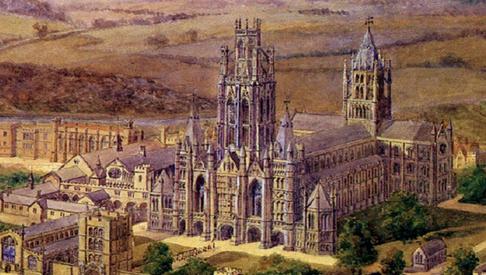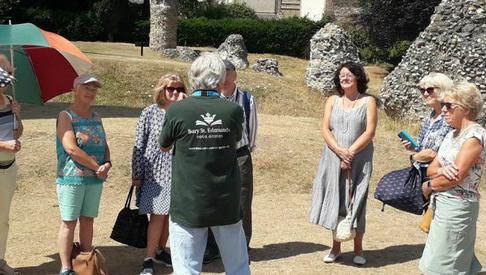
Back to Blogs
Discover
Meet The Stonemason Who Takes Care of the Abbey Ruins
A Q&A with Jonathan Presley, a freelance stonemason who has been commissioned by English Heritage to work on the Abbey remains that are under their care in the Abbey Gardens.

Firstly, for those readers that aren’t familiar with what a bricklayer/mason does, please can you explain a bit about what you do?
As a bricklayer/mason my work was mainly restoring churches working with flints, cut dressed stone and bricks. As I have mainly been involved with historic restoration and conservation of all types of buildings in my working life, I have gained and learned many skills and knowledge.
How did you get into being a bricklayer /mason?
By chance I started watching a programme about the restoration of a village church.
Working and restoring the flint and stonework of the church, after watching the programme which I found very interesting and thought no more of it. Just a few months later while looking to change my employment, I went to the local job centre and saw by chance a job being advertised by a local firm called Ellis Gregory & Sons of Shimpling who were looking to train a young person in the skills to restore historic churches working with flint and stonework. I applied for the job and was successful, and have carried on with historic restoration building and brickwork work ever since.
Do you have a preference as to the kind of stone that you work with?
Generally I am happy to work with all types of stone and flint but I do enjoy working with knapped flints creating flushwork panels especially on the churches I have worked on in the past.
What are the essential tools of your craft?
Most of my hand tools that I use are the same or similar to those used hundreds of years ago such as trowels, lump hammer and chisels, levels, scutch hammer, brick hammer and masonry saw. These are just a few of the main ones as well as power tools for cutting and drilling stone and masonry.
How do you go about looking after the abbey ruins? How do you do repairs to the ruins when they are hundreds of years old? Are there special materials?
Most of the repairs I carry out on the ruins consist of consolidation and pointing to the exiting flint core work. Firstly any loose areas of mortar are carefully raked back and pointed, and loose flints are consolidated or rebuilt back all using well gritted lime mortar with stippled brush finish I only carry out what is necessary to help conserve the ancient walls.
What's your personal favourite part of the ruins?
My favourite part of the ruin is the crypt where St Edmund's shrine would have been.

What stone is the abbey ruins made of?
Barnack stone was the main stone used for building the Abbey with flint rubble used to build the core work, sadly all that’s left of the Abbey is mostly the flint core work.
What is the best preserved part of the ruins.
The best preserved part must be the Abbey Gate, with some fine carved stone work still remaining, a magnificent medieval stone building.

You recently mended a large part of the boundary wall in Eastgate Street that collapsed when a tree fell on it, what has been the largest repair you have done on the Abbey Ruins?
The largest wall repair I have done is a section of precinct wall near the sensory garden where a large section collapsed and also a section of precinct wall by the river.
What items have you found hidden in the walls?
We understand a China doll was found and there is also a little skull near the Abbey Gate that everyone finds fascinating!
Sadly I have never found anything in the wall but maybe one day ...
Related Posts

Abbey of St Edmund 1000th Anniversary…
View More

43 Facts About the Abbey of St Edmund
The Abbey of St Edmund was one of the most famous and…
View More
Enjoy Free Online Talks on the Abbey of St…
A series of FREE, online talks, to mark 1000 years…
View More
New-Look Guides Reveal their Abbey Tours
Bury St Edmunds Tour Guides Offer Abbey-specific tours…
View MoreRelated Blogs

News
Bury Tour Guides to launch…
Bury St Edmunds Tour Guides to Introduce new tours in…

News
Town’s Museum Forms New…
Moyse’s Hall Museum will be forging links with a…

News
St Edmundsbury Cathedral…
St Edmundsbury Cathedral in Bury St Edmunds is…

News
Bury St Edmunds & Beyond…
Step inside many of Bury St Edmunds historic buildings…

News
Bury's Best Pubs with a Past
some notable, historic and somewhat quirky pubs and…
Latest news

News
How to Spend Betwixtmas in Bury St Edmunds & Beyond
The post Christmas period is the perfect time to get out and about before the new year kicks in, and you’ll find plenty of activities and places to visit in Bury St Edmunds and beyond.

News
Parents Guide to Pre Christmas Entertainment
It's the school holidays and with Christmas just around the corner we've put toegther a guide on places to take the kids to keep them entertained until Santa visits!

News
Enjoy a Festive Afternoon Tea in 2025
Celebrate the Christmas season with a festive afternoon tea in Bury St Edmunds & Beyond...

News
Festive Winter Walks
Get outside and enjoy the fresh crisp winter air with one of these walks in Bury St Edmunds and Beyond!

News
Bury Tour Guides to launch new tours next year after successful 2025
Bury St Edmunds Tour Guides to Introduce new tours in 2026 and continue the successful Food and Drink Tours!

News
New in Bury St Edmunds For 2026
A sneak peak into new attractions visitors can enjoy in Bury St Edmunds in 2026.

News
Baby It's Cold Outside... Things To Do When the Weather Turns Frosty
Just because the temperature’s dropped doesn’t mean the fun has to! If you’re visiting town during the chillier months, there’s still plenty to see, do, and experience.

News
Places to sit by a roaring fire in Bury St Edmunds & Beyond
Warm up by a roaring fire this winter in Bury St Edmunds & Beyond...

News
Christmas Park and Walk 2025
Additional parking has been provided by West Suffolk Council in partnership with Greene King this Christmas.
